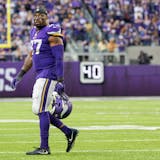The Vikings can officially trade Adrian Peterson today. Six months ago, that would have sounded crazy. Now, it's a practical question to wonder if the Vikings are going to, in fact, trade the player who was the face of the franchise for so many years — and to wonder, too, what they might get in return.
It's in that second part that we delve into a strange meditation on the relative value of draft picks, not just in the NFL but in all four of the major U.S. men's pro sports leagues.
ESPN's John Clayton said on the radio Monday that he thinks Peterson would fetch a fourth-round pick in a trade. That's it — and that's the best-case scenario, per Clayton. To a Vikings fan, particularly one who hasn't paid much attention to the ways of the modern NFL, that might seem as absurd as the notion of trading Peterson would have been before this past year happened.
To be sure, it's just the opinion of one man. But it's probably pretty accurate based on the value of LeSean McCoy. Brandon Marshall, a talented wide receiver, fetched a fifth-round pick in a trade with the Jets.
What's hard to wrap one's head around, at times, is how much the value of a draft pick changes from league to league — and from generation to generation. Here's our attempt at assigning value, when it comes to trades:
In the NBA, a top-five pick is gold. A lottery pick is valuable. A first-round pick is useful. A second-round pick? Depends on how you use it, but it's largely used as a throw-in when it comes to trade value. And that's it. There are only two rounds. If you want to crack an NBA roster, you had best be the elite of the elite.
In the NHL, a first-round pick is gold. A second- or third-round pick is valuable, but not as much so as in the NFL. These are the picks that fetch valuable rental players in deadline trades. Beyond that, depth can be found but the odds get longer.
In the NFL, it feels like every draft pick has value. First-round picks are of course the gold standard. Second-round picks are still blue-chip talents. Third-round picks routinely become NFL starters. Fourth-round picks might be projects, but they are still valuable. Same for fifth-round picks. Sixth- and seventh-round picks can be marginal, but they still have value.


